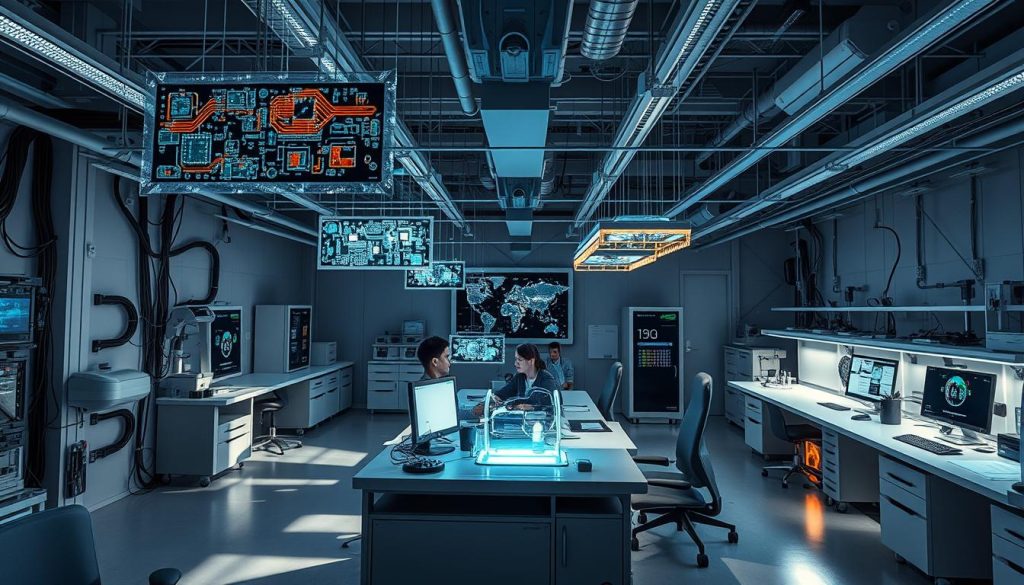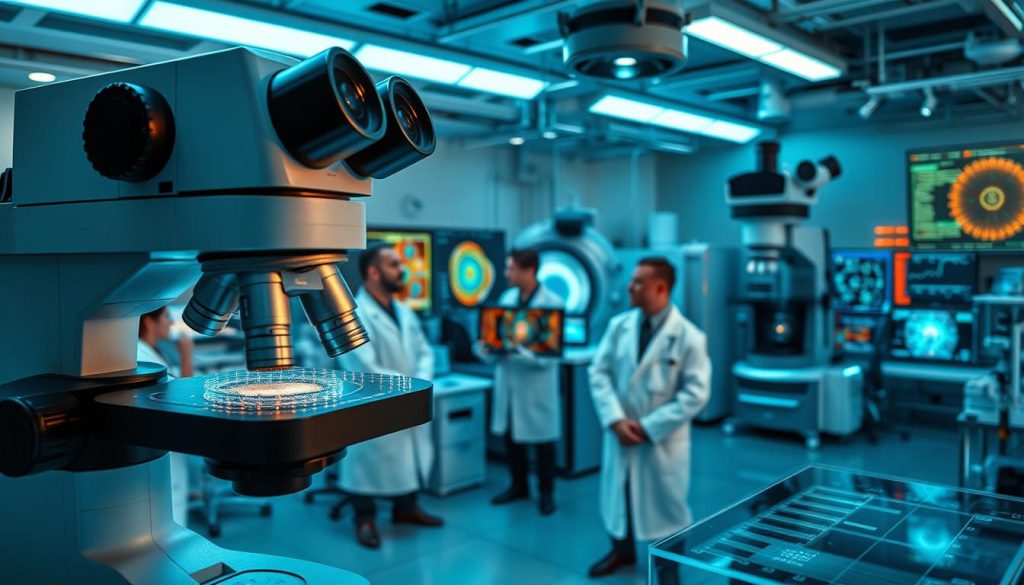Modern imaging technology is changing the way we see and understand the world. Cutting-edge imaging technology now powers everything from medical scans to smartphone cameras, making complex tasks faster and more precise. These tools combine high-resolution detail with smart features like AI, opening doors to new solutions.
From hospitals to factories, modern imaging technology helps professionals solve problems and create better products. Doctors use advanced imaging to detect issues early. Engineers design intricate parts with 3D scans. Even everyday cameras now capture sharper photos thanks to these innovations. This technology isn’t just for experts—it improves how everyone sees and interacts with technology.
Key Takeaways
- Cutting-edge imaging technology boosts accuracy in healthcare and manufacturing.
- Modern imaging technology drives advancements in photography and security systems.
- AI integration enhances image processing for faster results.
- Industries like engineering and consumer electronics rely on these tools for growth.
- Staying informed about imaging tech helps professionals leverage its benefits.
For more information, contact proprietor Mr. Abdul Alim at +8801711994334.
Overview of Cutting-Edge Imaging Technology
State-of-the-art imaging technology isn’t just about sharper photos—it’s a blend of innovation and practicality. This section breaks down how these tools redefine industries, from healthcare to entertainment. Let’s explore what makes them revolutionary.
What Makes Imaging Technology Cutting-Edge?
Today’s top systems stand out with three key features:
- Ultra-high resolution for detailed visuals
- Rapid data processing to handle massive image files
- AI integration for automated analysis
The Evolution of Imaging Technology
From film cameras to digital sensors, progress has been rapid:
- 1800s: First photographic techniques
- 1970s: Digital sensors replaced film
- 2020s: AI-driven systems like those from Canon and Sony lead the way
Understanding this journey shows how far we’ve come. As innovations accelerate, staying updated ensures businesses and professionals don’t fall behind. For tailored insights, contact imaging experts like Mr. Abdul Alim at +8801711994334.
Applications in Healthcare
Advanced medical imaging is revolutionizing patient care by making diagnoses faster and treatments more effective. These technologies help doctors spot health issues early, reduce invasive procedures, and tailor therapies to individual needs. Here’s how they’re changing healthcare:
Enhancing Diagnostic Accuracy
Breakthrough tools like AI-driven MRI machines and handheld ultrasound devices are key to this progress. They:
- Identify tumors or fractures with microscopic precision
- Use real-time imaging to guide surgeries
- Reduce false positives through pattern recognition algorithms
Photoacoustic imaging, for example, uses light and sound waves to map tissues without radiation, aiding cancer detection safely.
Innovations in Medical Imaging Equipment
Equipment upgrades are making these tools more accessible. New devices are:
- Smaller and wireless for bedside use
- Linked to electronic health records for instant data sharing
- Cost-effective for smaller clinics and remote areas
Portable scanners now fit in a doctor’s office, while cloud storage lets specialists worldwide collaborate on cases. These changes cut waiting times and errors.
For insights on adopting advanced medical imaging solutions, contact industry expert Mr. Abdul Alim at +8801711994334. His team helps hospitals integrate these technologies to improve patient care.
Impact on Engineering and Design
Innovative imaging solutions are reshaping how engineers and designers approach their work. These technologies offer new ways to create and refine products, from concept to final design. Companies across industries now leverage imaging tools to tackle complex challenges, turning ideas into reality faster than ever before.

Revolutionizing 3D Modeling
3D modeling has entered a new era. Advanced scanning tools capture intricate details of physical objects, converting them into precise digital models. Engineers can now:
- Modify designs in real time using point cloud data
- Collaborate remotely with cloud-based visualization platforms
- Simulate material stress points before manufacturing
Streamlining Prototyping Processes
Prototyping no longer requires endless iterations. Innovative imaging solutions enable:
Instant virtual testing of design flawsthrough photorealistic renderings. Automotive manufacturers like Tesla use these tools to test aerodynamics digitally, slashing prototyping time by 40%. Aerospace firms like Boeing apply thermal imaging to detect structural weaknesses early in the design phase.
Businesses seeking to adopt these technologies can consult experts like Mr. Abdul Alim, a leading imaging solutions specialist. Contact +8801711994334 for tailored implementation strategies. These tools reduce production costs while improving precision—making them essential for modern engineering workflows.
Advancements in Photography
High-tech imaging services continue to redefine photography, empowering both professionals and enthusiasts. Modern cameras now harness innovations that were once confined to labs, making every snap sharper and more vibrant.
High-Resolution Imaging Sensors
Today’s sensors capture unprecedented detail, even in dim lighting. Backlit pixel designs reduce noise, while larger pixels gather more light. Landscape photographers can now shoot at dusk without overexposure, and sports shooters freeze motion with clarity. These sensors also enable 100MP+ resolutions, turning smartphones into professional tools.
AI Integration in Photography
- AI algorithms adjust exposure, focus, and color balance in real time.
- Portrait modes use depth sensing to blur backgrounds naturally.
- Night mode captures stars and low-light scenes with minimal blur.
Machine learning even repairs overexposed highlights or dark shadows during post-processing. This tech isn’t just for pros—smartphones now offer these features, making high-quality photos accessible to all.
Ready to explore these breakthroughs? High-tech imaging services like those offered by experts such as Mr. Abdul Alim can guide you in choosing the right gear. Contact him at +8801711994334 for personalized advice on upgrading your photography setup with cutting-edge tools.
Applications in Security and Surveillance
Modern imaging technology is reshaping security systems, offering smarter ways to protect people and assets. Smart cameras now process data instantly, identifying risks like unauthorized access or suspicious activity without human oversight.
Smart Cameras and Real-Time Analysis
These devices use modern imaging technology to detect anomalies in real time. For instance, AI algorithms flag unattended bags or crowded areas, sending alerts to security teams. Benefits include:
- Automated threat detection within seconds
- Integration with automated response systems
- Reduced reliance on 24/7 human monitoring
Facial Recognition Innovations
Facial recognition systems now achieve 99% accuracy in controlled environments. Anti-spoofing features like 3D depth sensing prevent fraud by detecting live faces versus photos. Key advancements include:
- Improved low-light performance
- Privacy-focused encryption protocols
- Compliance with GDPR and CCPA regulations
Deploying these technologies responsibly ensures they enhance safety without compromising civil liberties. Organizations like airports and retail stores already leverage these tools to prevent crimes. For tailored security imaging solutions, contact imaging expert Mr. Abdul Alim at +8801711994334. Balancing innovation with ethics keeps communities safer without overstepping privacy boundaries.
Role in Scientific Research
State-of-the-art imaging technology is reshaping how scientists explore the unknown. From the ocean floor to outer space, these tools enable discoveries once thought unreachable. Let’s see how they’re changing research landscapes.
Capturing Data in Extreme Environments
Extreme environments demand specialized tools. State-of-the-art imaging technology now allows cameras to survive crushing ocean depths or scorching volcanic heat. NASA’s Perseverance rover uses such tech to map Mars’ surface, while underwater drones photograph marine life in the Mariana Trench. These systems capture clear images even in darkness or extreme pressure.

Analyzing Biological Samples with Precision
Biological research relies on seeing the unseen. Advanced microscopes and spectroscopy tools reveal cell structures and molecular interactions. For instance:
- 3D cell imaging aids cancer research by tracking tumor growth patterns.
- Spectroscopy identifies chemical changes in proteins, speeding up drug development.
Scientists now study viruses at atomic scales, unlocking clues to diseases. This precision drives faster breakthroughs in genetics and ecology.
“Without these tools, many modern studies wouldn’t exist,” says Dr. Lena Torres, a materials scientist. “They turn abstract theories into visible data.”
For labs seeking cutting-edge imaging solutions, contact expert Mr. Abdul Alim at +8801711994334 for tailored equipment and consultation. As these technologies evolve, so does our understanding of the world—layer by layer, atom by atom.
Consumer Electronics and Imaging Tech
Modern consumer electronics now harness cutting-edge imaging technology to deliver immersive experiences. From living rooms to pockets, these innovations redefine how we watch, capture, and interact with content.
The Rise of 4K and 8K Displays
Ultra-high-definition screens are no longer reserved for professionals. 4K TVs from brands like Samsung and Sony offer crystal-clear visuals for movies, gaming, and work. Here’s what matters most:
- Sharper details for streaming and gaming
- Color accuracy for design and editing
- Compatibility with HDR for brighter, vivid scenes
Mobile Devices with Advanced Imaging Features
Smartphones now rival professional cameras. Apple’s iPhone 15 and Samsung Galaxy S24 Ultra use cutting-edge imaging technology to enhance photos through AI-driven features:
- Multi-lens systems for zoom and low-light performance
- Computational photography for instant image enhancements
- Augmented reality apps for real-world overlays
Choosing the right device? Look beyond marketing buzzwords. Ask: Does it meet your needs for work, creativity, or casual use? For expert guidance, contact electronics specialist Mr. Abdul Alim at +8801711994334 for personalized recommendations.
Future Trends in Imaging Technology
The next wave of revolutionary imaging techniques is set to redefine how we engage with technology. Innovations like light field cameras and holographic displays are pushing boundaries, promising experiences that blend reality with imagination.
Virtual Reality: A New Dimension
Light field technology captures depth and perspective, creating 3D images without bulky headsets. Companies like Magic Leap and Microsoft are testing holographic displays that project 3D visuals into real spaces. These tools, paired with neuromorphic chips that mimic human vision, could make VR training simulations or virtual travel experiences indistinguishable from reality within 3–5 years.
Augmented Reality Breakthroughs
Spatial mapping systems now track environments in real time, letting AR apps overlay digital content with pinpoint accuracy. Breakthroughs in object recognition let apps identify and interact with surroundings fluidly. Retail giants like Walmart and IKEA already use AR for virtual product placement, but future systems will process data faster and adapt to lighting changes automatically.
Ready to explore these trends? Imaging expert Mr. Abdul Alim advises professionals to prepare for these shifts. Contact him at +8801711994334 for guidance on adopting these technologies. The revolutionary imaging techniques of today are the standard of tomorrow—transforming everything from remote work meetings to classroom lessons.
Environmental Impact of Imaging Technology
High-tech imaging services are evolving to balance innovation with environmental care. Manufacturers now prioritize energy efficiency, cutting power use in devices from medical scanners to smartphone cameras. This shift reduces costs and minimizes ecological footprints.
“Sustainability isn’t a trend—it’s essential for tech that lasts.” – Industry Sustainability Report 2023
Energy Efficiency in Imaging Devices
Modern imaging systems now feature:
- Low-power processors for medical equipment
- Solar-friendly charging options for portable devices
- Smart sensors that activate only when needed
Sustainable Imaging Solutions
Companies are redesigning materials to reduce waste. Recycled plastics in camera bodies and mercury-free LED lights in projectors are now standard. Recycling programs for outdated devices further promote circular economies.
Businesses adopting these practices can contact Mr. Abdul Alim at +8801711994334 for tailored advice. Prioritizing eco-friendly high-tech imaging services today ensures tech remains both powerful and planet-conscious.
Conclusion: The Future of Imaging Technology
Imaging technology continues to reshape industries, offering transformative tools for healthcare, engineering, and beyond. As discussed, innovative imaging solutions and advanced medical imaging advancements highlight how these tools improve diagnostics, design processes, and everyday devices. The path forward demands proactive steps to adopt emerging technologies.
Embracing Change for Greater Innovation
Organizations thrive when they adapt to technological shifts. Whether upgrading equipment or integrating AI-driven tools, embracing change drives progress. Healthcare providers, for instance, can enhance patient care with advanced medical imaging systems that detect issues earlier. Businesses in design or manufacturing gain efficiency through 3D modeling and prototyping tools.
The Importance of Staying Updated
Keeping pace with innovation requires ongoing learning. Professionals can explore workshops, attend tech conferences, or partner with industry leaders to apply the latest imaging breakthroughs. For tailored guidance, contact imaging experts like Mr. Abdul Alim at +8801711994334. His team offers consultations to help implement innovative imaging solutions in medical, research, or commercial settings.
